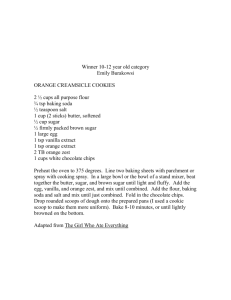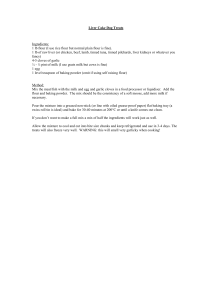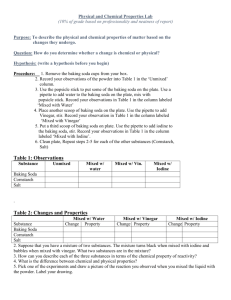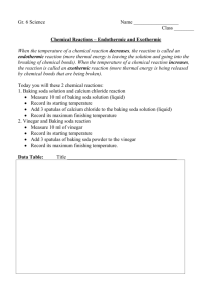Woman`s Club Cook Book - Newcastle Historical Society
advertisement
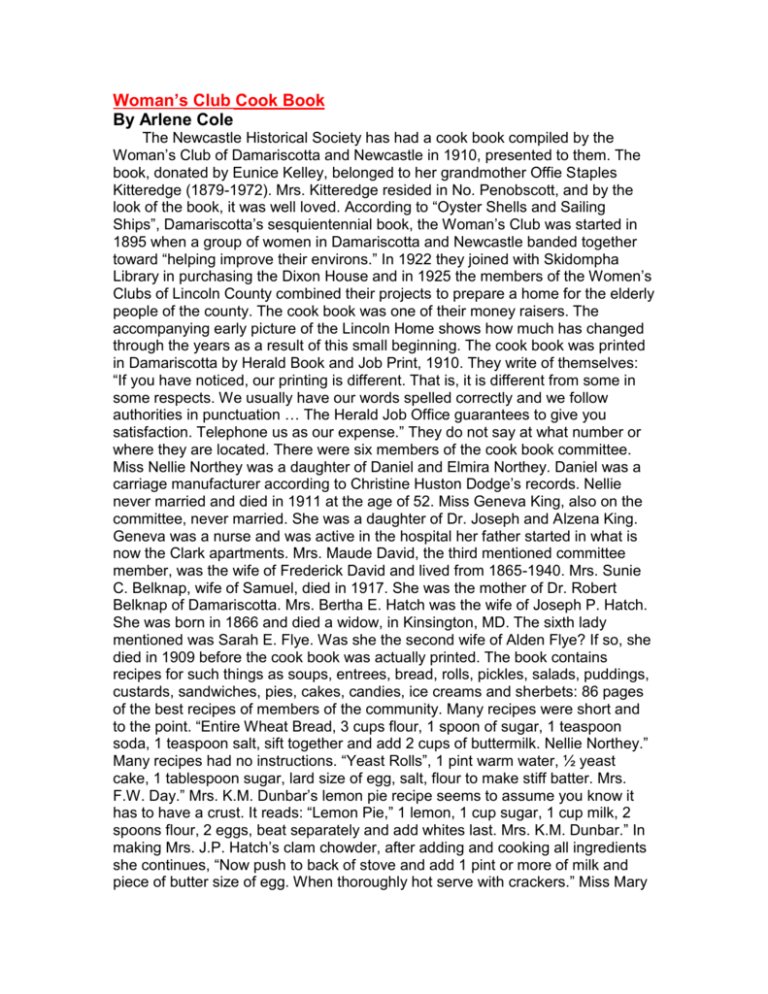
Woman’s Club Cook Book By Arlene Cole The Newcastle Historical Society has had a cook book compiled by the Woman’s Club of Damariscotta and Newcastle in 1910, presented to them. The book, donated by Eunice Kelley, belonged to her grandmother Offie Staples Kitteredge (1879-1972). Mrs. Kitteredge resided in No. Penobscott, and by the look of the book, it was well loved. According to “Oyster Shells and Sailing Ships”, Damariscotta’s sesquientennial book, the Woman’s Club was started in 1895 when a group of women in Damariscotta and Newcastle banded together toward “helping improve their environs.” In 1922 they joined with Skidompha Library in purchasing the Dixon House and in 1925 the members of the Women’s Clubs of Lincoln County combined their projects to prepare a home for the elderly people of the county. The cook book was one of their money raisers. The accompanying early picture of the Lincoln Home shows how much has changed through the years as a result of this small beginning. The cook book was printed in Damariscotta by Herald Book and Job Print, 1910. They write of themselves: “If you have noticed, our printing is different. That is, it is different from some in some respects. We usually have our words spelled correctly and we follow authorities in punctuation … The Herald Job Office guarantees to give you satisfaction. Telephone us as our expense.” They do not say at what number or where they are located. There were six members of the cook book committee. Miss Nellie Northey was a daughter of Daniel and Elmira Northey. Daniel was a carriage manufacturer according to Christine Huston Dodge’s records. Nellie never married and died in 1911 at the age of 52. Miss Geneva King, also on the committee, never married. She was a daughter of Dr. Joseph and Alzena King. Geneva was a nurse and was active in the hospital her father started in what is now the Clark apartments. Mrs. Maude David, the third mentioned committee member, was the wife of Frederick David and lived from 1865-1940. Mrs. Sunie C. Belknap, wife of Samuel, died in 1917. She was the mother of Dr. Robert Belknap of Damariscotta. Mrs. Bertha E. Hatch was the wife of Joseph P. Hatch. She was born in 1866 and died a widow, in Kinsington, MD. The sixth lady mentioned was Sarah E. Flye. Was she the second wife of Alden Flye? If so, she died in 1909 before the cook book was actually printed. The book contains recipes for such things as soups, entrees, bread, rolls, pickles, salads, puddings, custards, sandwiches, pies, cakes, candies, ice creams and sherbets: 86 pages of the best recipes of members of the community. Many recipes were short and to the point. “Entire Wheat Bread, 3 cups flour, 1 spoon of sugar, 1 teaspoon soda, 1 teaspoon salt, sift together and add 2 cups of buttermilk. Nellie Northey.” Many recipes had no instructions. “Yeast Rolls”, 1 pint warm water, ½ yeast cake, 1 tablespoon sugar, lard size of egg, salt, flour to make stiff batter. Mrs. F.W. Day.” Mrs. K.M. Dunbar’s lemon pie recipe seems to assume you know it has to have a crust. It reads: “Lemon Pie,” 1 lemon, 1 cup sugar, 1 cup milk, 2 spoons flour, 2 eggs, beat separately and add whites last. Mrs. K.M. Dunbar.” In making Mrs. J.P. Hatch’s clam chowder, after adding and cooking all ingredients she continues, “Now push to back of stove and add 1 pint or more of milk and piece of butter size of egg. When thoroughly hot serve with crackers.” Miss Mary Metcalf’s sponge cake has no pan size suggestion or temperature or time for baking. It reads in total, “Sponge Cake,” 3 eggs, 1 cup of sugar, 2 tablespoonfuls of water, teaspoonful of soda, 1 of cream tartar, 1 cup of flour, pinch of salt. Miss Mary Metcalf.” There are ads by the Newcastle National Bank, Thomas E. Gay and Son and Fred Harrington’s Furniture, “new and up-to-date furniture with right prices” in both Damariscotta and Newcastle. Ellis W. Nash advertises, “Notice! Booklovers! If you contemplate adding to your library, give us a call. We have on hand some standard works at low prices.” Page’s Marble and Granite Works dealt in “High Grade Marble and Granite Monuments, Tablets and General Cemetery Work … All work delivered and set up by experienced men anywhere in New England.” The Fiske House has “Livery in connection … Steam heat, Electric Lights and Telephone Connection.” But the Maine Hotel Stable has “Hacks to all trains, Carriages for Funerals … Local and Long Distance Telephone.” On page 18 one is cautioned that “Bad Soda Spoils Good Flour.” The Arm & Hammer Soda brand of soda suggests one use their soda as “it costs no more than inferior packages – never spoils the flour – always keeps soft.” Page 53 cautions one to use “Royal” baking powder. “Look out for alum baking powder. Do not permit them to come into your house under any consideration. They add an injurious substance to your food, destroying in part its digestibility. Alum baking powders may be known by their price. Baking powders at a cent an ounce or ten or twenty-five cents a pound are made from alum. Avoid them. Use no baking powder unless the label shows it is made from cream of tartar … In recipes calling for one teaspoonful of soda and two of cream of tartar, use two spoonfuls of Royal, and leave the cream of tartar and soda out. You get the better food and save much trouble and guess work.” Our thanks to Eunice Kelley for a glimpse into the kitchen of nearly 100 years ago.
